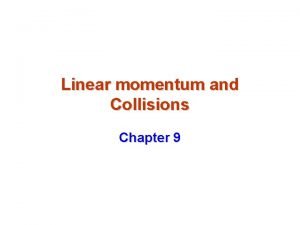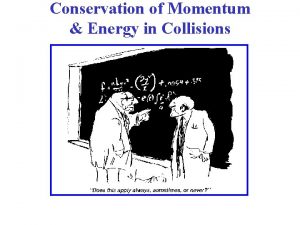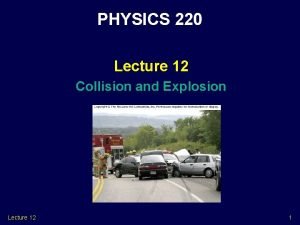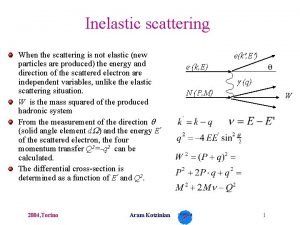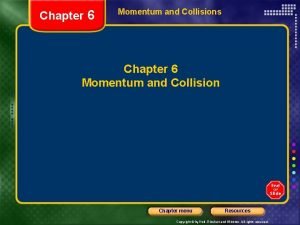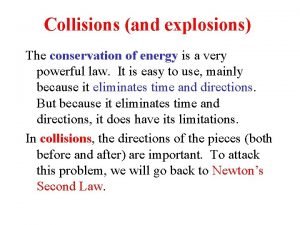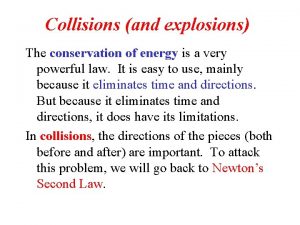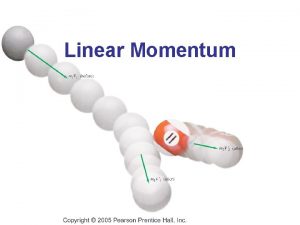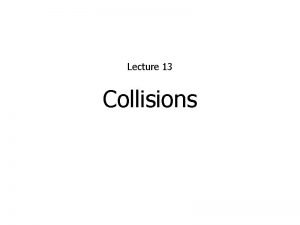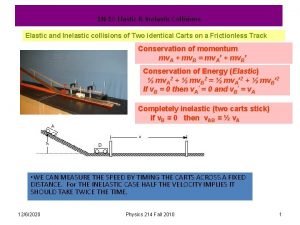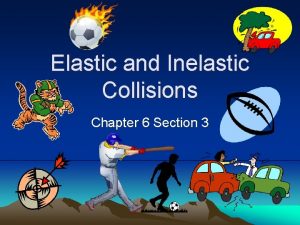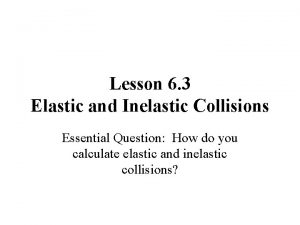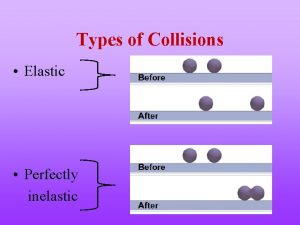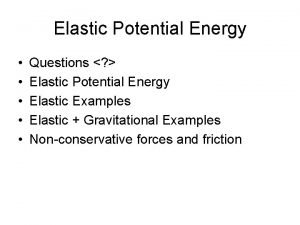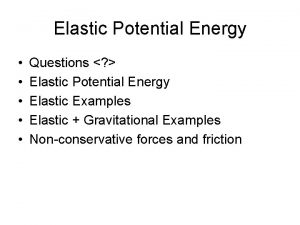Elastic and Inelastic Collisions Chapter 6 Section 3















- Slides: 15

Elastic and Inelastic Collisions Chapter 6 Section 3

Collisions • There are many different collisions in which two objects collide. – Sports – Vehicles – Arrow and target

Kinetic Energy and Collisions • Momentum is always conserved in a collision, but the total kinetic energy is generally not conserved. • Some of the energy is converted to thermal energy (heat) and internal elastic potential energy when the objects deform.

Perfectly Inelastic Collisions • Perfectly Inelastic collisions – A collision in which two objects stick together and move with a common velocity after colliding. • Examples: – Arrow hitting a target – Bullet lodging into a wood block – Meteorite colliding with Earth and becomes buried

Perfectly Inelastic Collisions m 1 v 1 i + m 2 v 2 i = (m 1+m 2)vf • Since the objects stick together after the collision, the masses must be added together for the final velocity.

Distinctions Between Collisions • Elastic Collision – Objects maintain their original shape and are not deformed after colliding. • Inelastic Collision – Objects are deformed during the collision and lose kinetic energy. • Perfectly Inelastic Collision – Objects join together after a collision to form one mass.

Kinetic Energy Lost • Energy is lost during an inelastic collision and not a elastic collision. • In most cases energy is lost during a perfectly inelastic collision, but not always. – How much deformation and how the objects stick together play a factor.

Kinetic Energy Equations KElost = KEi – Kef Kinetic Energy Lost = Initial Kinetic Energy – Final Kinetic Energy

Example Problem • A clay ball with a mass of 0. 35 kg hits another 0. 35 kg ball at rest, and the two stick together. The first ball has an initial speed of 4. 2 m/s 1. What is the final speed of the balls? 2. Calculate the decrease in kinetic energy that occurs during the collision. 3. What percentage of the kinetic energy is converted to other forms of energy?

Example Problem Answers 1. 2. 1 m/s 2. 1. 6 J 3. 52%

Elastic Collisions • Elastic Collisions – A collision in which the total momentum and the total kinetic energy remains constant. • The objects remain separate after the collision. • Examples: – Kicking a soccer ball with your foot – Hitting a baseball with a bat – Billiards

Everyday Collisions • Most collisions are neither elastic or perfectly inelastic in everyday activities. • In most collisions, kinetic energy is lost. – This places them into the category of inelastic collisions.

Kinetic Energy and Elastic Collisions • Kinetic energy is conserved in elastic collisions. • The total momentum and the total kinetic energy remain constant through out the collision.

Momentum and Kinetic Energy Equations m 1 v 1 i + m 2 v 2 i = m 1 v 1 f + m 2 v 2 f • Momentum equation can be used for all collisions. ½m 1 v 1 i²+ ½m 2 v 2 i²= ½m 1 v 1 f²+ ½m 2 v 2 f² • Kinetic Energy equation can only be used for elastic collisions.

Making Sure Collisions Are Elastic • To check and see if a collision is an elastic collision: – Solve the problem using the conservation of momentum equation. – Plug the velocities into the conservation of kinetic velocity equation and see if the total initial velocity and the total final velocity are equal. – If they are, then it is a true elastic collision.
 What makes some collisions elastic and others inelastic
What makes some collisions elastic and others inelastic What is inelastic collision
What is inelastic collision Elastic vs inelastic vs perfectly inelastic
Elastic vs inelastic vs perfectly inelastic Is angular momentum conserved in an inelastic collision
Is angular momentum conserved in an inelastic collision Elastic and inelastic collision
Elastic and inelastic collision Types of collisions worksheet
Types of collisions worksheet Elastic scattering vs inelastic
Elastic scattering vs inelastic An estimated force time curve for a baseball
An estimated force time curve for a baseball Elastic fibers
Elastic fibers Chapter 6 momentum and collisions
Chapter 6 momentum and collisions A 1850 kg luxury sedan stopped
A 1850 kg luxury sedan stopped A roller coaster climbs up a hill at 4m/s and then zips
A roller coaster climbs up a hill at 4m/s and then zips Collisions and explosions
Collisions and explosions Collisions and explosions
Collisions and explosions Inelastic collision examples
Inelastic collision examples Loss of kinetic energy in inelastic collision
Loss of kinetic energy in inelastic collision

